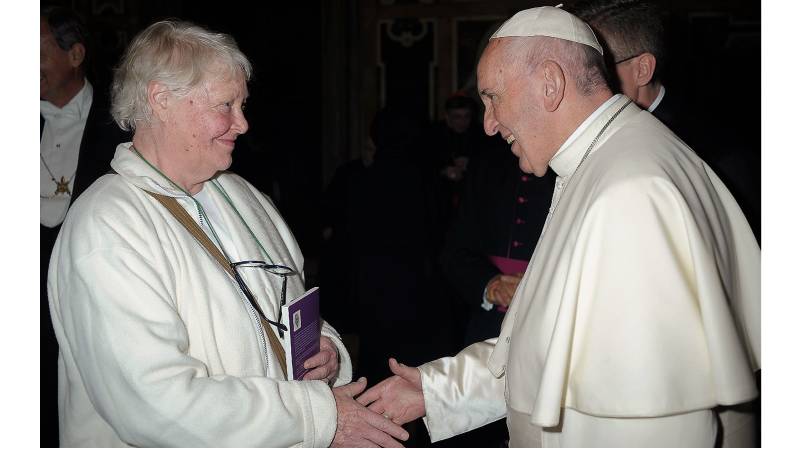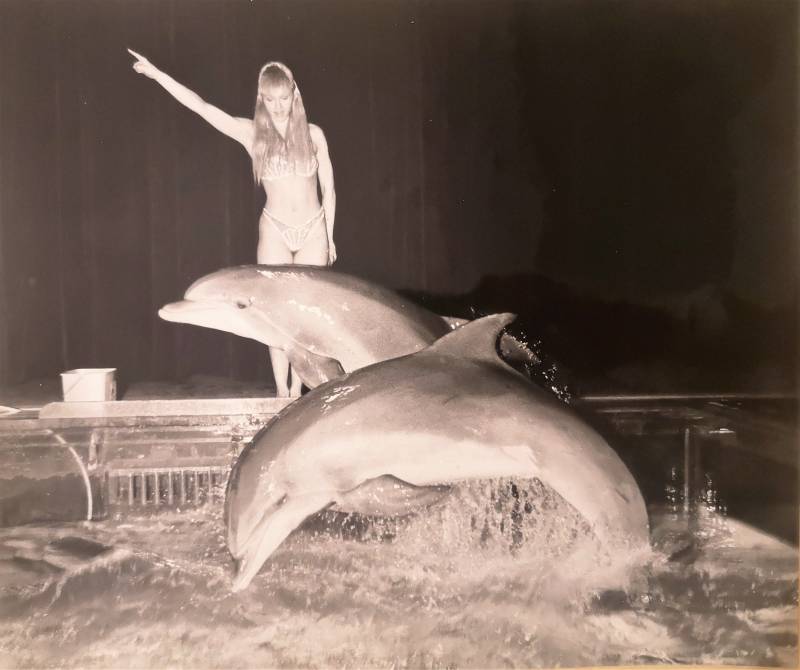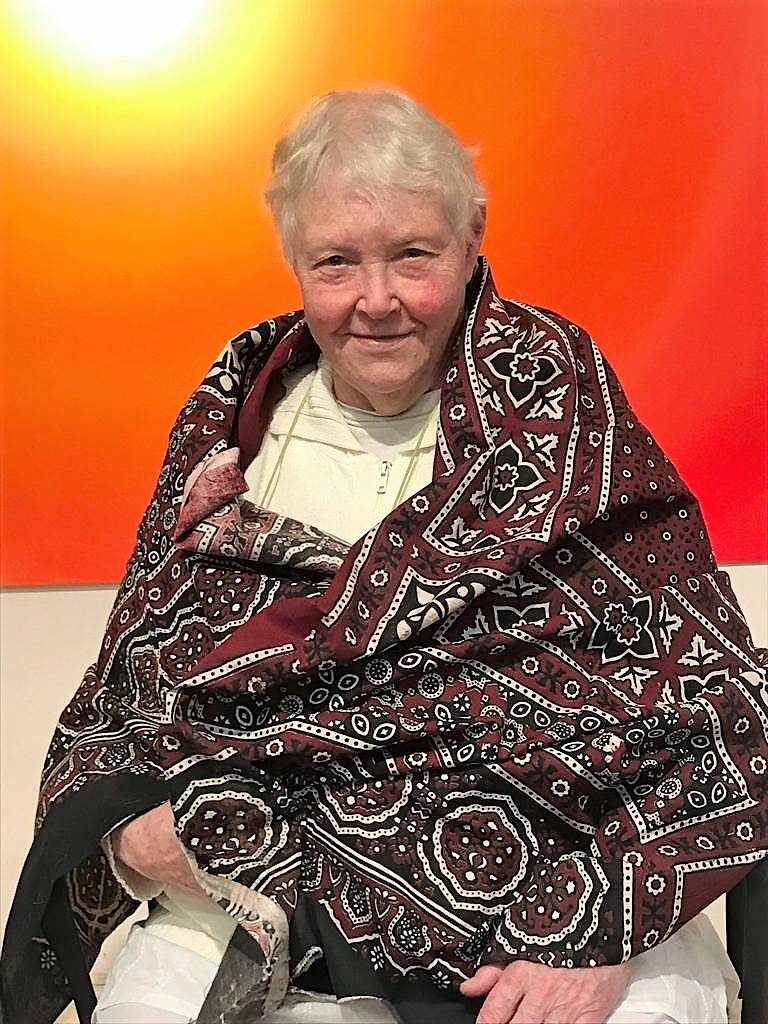
Wendy Farrington, born on 01 February 1941, embarked on a remarkable journey that led her from a world-class girls' boarding school in Belgium to the prestigious Monte Carlo Dames De St Maur school. Her early years were shaped by the aftermath of World War II, where she witnessed the suffering of the German people. However, it was her passion for skiing and dancing that truly ignited her spirit during her school days. Choosing to pursue a career in dance, Marjorie joined the renowned theatre scene in Paris, captivating audiences with her mesmerising performances. But her journey didn't stop there. She took an unexpected turn and dove into the world of dolphin training, combining her skills as a dancer with the art of training these majestic creatures. This unique path showcased her boundless enthusiasm and love for the arts.
In the 1980s, Wendy’s life took another transformative twist when she joined the Brahma Kumaris Movement. Since then, she has been at the helm of the Brahma Kumaris Centre in Rome, Italy. Leading this spiritual movement in one of the most challenging environments, Wendy, along with her colleague Radha Gupta, conducts workshops and conferences, focusing on the spiritual development of individuals, fostering balanced lives, nurturing responsible relationships, and imparting essential personal management skills. The Brahma Kumaris Center in Rome serves as a sanctuary for those seeking guidance and growth in their spiritual journeys.
During the interview at Via Laura Mantegazza in Rome, Wendy Farrington shared captivating insights into her life and mission. Here are some excerpts:
***
Zaffar Junejo (ZJ): Could you tell us about yourself?
Wendy Farrington (WF): My name is Wendy Farrington. I was born on 01 February 1941. My father, John Reginald Farrington, was an officer in the British Army, reaching the rank of colonel before his retirement. My mother, Ailsa Morgan, was a housewife. My father served at various cantonments and garrisons of the British Army, including Hyderabad (Sindh, Pakistan), the southern coast of England, and post-World War II Germany in 1946.
ZJ: Were other members of your family also in the British Army?
WF: Yes, spanning almost three generations, my family has a strong tradition of service in the British Army. My great uncle on my mother’s side, Sir Henry Havelock, served in the English army during the 1857 revolt, stationed at Kanpur, where he defended British installations. Interestingly, despite our military background, all our family members were settled in India, considering it our true home, not Britain.
ZJ: How did your father meet your mother?
WF: I don't have exact details, but from what I have heard and gathered from their conversations, they met in London. My mother had two daughters from her first marriage. Her husband asked for a divorce, the first pronounced in India for the wife abandoning her husband. Morgan was my mother’s maiden name, Bendle her husband. He was also an army officer. After the divorce, my half-sisters used to come home now and again on holiday to see their mother. I recall my father’s and mother’s fondness for hunting, evident in our home with shotguns and numerous cartridge boxes.
ZJ: Did you and your mother also move with him to Germany? If so, what are your memories of post-war Germany?
WF: Yes, we moved with him to Germany. While I can’t recall his exact duties, he was the commanding officer of the Lower Rhine district. I vaguely remember that he was stationed there to aid in the country’s reconstruction. His primary responsibilities included helping in getting the German economy active like opening the mines again after the wartime closedown. I remember a time when only apples and potatoes were abundantly available, as they required minimal human effort to grow, especially during the pre-war and post-war periods. My father encouraged me to play with German children. Our playground was bombarded buildings, and structures without roofs, windows, or doors, all fully or partially damaged. Attending social gatherings and family events of his colleagues or my friends was a regular occurrence. My father was very friendly and helped Germans get around the Army bureaucracy to their benefit. I distinctly remember cigarettes being a common item bought in bulk during every shopping trip. These were used as exchange, barter, as cigarettes and booze were not easily available for the Germans. With a couple of packs of cigarettes you could get hairdressing, sewing and a lot of other services without any exchange of money. Those were days I cherish, voluntarily queuing up for soup alongside German children and families. Perhaps my family was instrumental in teaching me the values of respect, equality, and empathy towards the German people, who were grappling with mental agony, depression, and disorientation after the war. I must express my gratitude to my English nanny Ms Hilde Gooder, who looked after me and taught me to paint, sew, knit and gather edible plants.
ZJ: Were you schooled in Germany?
WF: We moved to Germany when I was roughly five or six years old, but I wasn’t enrolled in any German school. Instead, I attended Belgium's Ursuline Convent Tildonk, a boarding school managed by nuns. The Ursuline Order was the first to dedicate itself to girls’ education, and it held a special place, especially during World War II as Vatican City asked all catholic convents, if possible to hide or help Jewish people to save their lives. Many nuns, including former military women, joined the school during that challenging time and they were later applauded for having saved countless Jewish children from the holocaust by hiding them in their enormous buildings.
ZJ: How do you recall your early education at Ursuline?
WF: It was a wonderful school with pupils from various nationalities and religions. The educational sanctity was palpable, with a sense of community and individuality. The architecture, particularly the dormitories, provided a communal living space while preserving personal privacy. I fondly remember my admission day, when my parents handed over not only their daughter but also shotguns and jewellery. The administrative nun, a former captain in the British Army, expertly checked the guns, leaving my father astonished. One memorable friend from those days is Sarah Postlethwaite, with whom I recently reconnected on Facebook after six decades. Afterwards, we moved to Monte Carlo.
ZJ: Did you continue your education in France?
WF: No, we moved to Monte Carlo, situated along the French Riviera. Most of the people think that it is in France or Italy. But it is an independent country; anyway, I joined Monte Carlo Dames De St Maur School, a renowned school of those times. My time there was marked by my passion for alpine skiing with dreams to participate in the Olympic Games, which I did in 1960 (California) and 1964 (Austria). In those days another dream was to become a veterinary professional.
ZJ: Did you pursue veterinary sciences as initially planned?
WF: No, due to the distance and financial constraints, I couldn’t pursue veterinary sciences in Paris. Instead, my mother suggested that I join a dance school, noting my sporty body. I joined a dance school at age 14, simultaneously with my time in Monte Carlo.
ZJ: What kind of dances were you trained in?
WF: While the school initially offered basic and advanced training in classical dance, I ended up as a Jazz dancer. Jazz dance, to me, embodies rhythm; a close connection with music; craftiness of the body movement; and an overall sense of excitement— in a way bodily expression more inclined to American aesthetic.
ZJ: Did you join any theatre or club?
WF: Yes, I joined the Bal du Moulin Rouge Theatre in France. The company organised dance parties, dinners, receptions, and other entertaining events. I worked there as a Jazz dancer and, interestingly, also as a dolphin trainer, participating in shows with dolphins in extremely cold water. But the theatre was one of the most famous cabarets in the world. The dolphin pool would emerge from beneath the stage when the stage rolled back.

ZJ: How did you communicate with the dolphins?
WF: Dolphins are cooperative and intelligent animals. Communication involved visual clues, body language, a friendly physical touch, and a soothing tone. Despite not understanding our language, they seemed to decode our body vibrations.
ZJ: Did you work or travel in America?
WF: Yes, I went to America for an artist contract, and after it ended, I couldn’t continue my stay. However, I could stay over there, if a new contract is issued or I marry an American national. I opted for a 'white marriage' to get legal paperwork, my colleague Rodney Texas and I lived together as a married couple. Surprisingly, what began as a contractual arrangement turned into a true marriage. Although I got the legal papers to stay and work in America, I eventually moved back to Europe, and our marriage ended in separation around 1969.
ZJ: How did you come across the Brahma Kumaris movement?
WF: I began to sense unhappiness within myself and my surroundings during my theatre life. In those days I wanted to create more happiness for myself and those around me. Seeking tranquillity, I delved into psychological literature, consulted psychologists, and finally, at a humanistic psychology congress where I was working as a translator, I met a German psychologist who introduced me to the Brahma Kumaris.
ZJ: Due to your association with the Brahma Kumaris, what changes occurred in your personality?
WF: Gradually, my swinging moods stabilised, and I became more reflective rather than instantly reactive. I learned to remain calm and positive in all situations, welcoming every occurrence as a challenge and an opportunity to learn. I found a sense of balance and centredness.
ZJ: How did you end up in Rome?
WF: I joined the Brahma Kumaris Center in Paris. I was tasked to work in Rome, perhaps, due to my European exposure and proficiency in multiple languages. Our early Rome team members included Laura, Dagmar, and myself. However, after two years Antonella, and Yolanda also joined. We initially faced challenges in a country resistant to new spiritual ideas. In 1984, we started our activities from a small flat, and our low-scale efforts continued until 2005. Later, we secured a slightly larger space, initiating courses and conferences.
ZJ: What types of courses were started?
WF: The courses focused on positive thinking, stress management, self-management, learning the art of calmness, and anger management, aligning with the principles of self-help discipline.
Q: How do Brahma Kumaris differ from other change-making spiritual organisations?
WF: Brahma Kumaris distinguish themselves in several ways. Unlike some organisations, we don’t convert people to Hinduism or advocate a sectarian version of religion. Our centres don’t offer exotic exercises for physical enhancement. Instead, we use music as a means for people to relax while connecting with the supreme-being.
ZJ: How do you view Brahma Kumaris' idea of celibacy?
WF: Celibacy, viewed differently in various cultures, is not seen as a sacrifice or a means to end troubled relationships by Brahma Kumaris. Instead, it is considered a way to cut down on 'inessentials' and focus on spiritual growth.
ZJ: How do you compare structured religions and spirituality in the context of Brahma Kumaris’ philosophy?
WF: Structured religions often attribute natural events to the will of God, placing responsibility outside of human actions. Brahma Kumaris, however, believe in the connection between human actions and outcomes. The wisdom shared is aimed at helping individuals lead fulfilled and peaceful lives.
ZJ: Why are people turning towards spirituality or the emotional aspect of their development?
WF: Many big religions have become entangled in structures and rituals, neglecting the spiritual aspect of human needs. With a decline in religious worshipers, people find it challenging to link religious practices with personal crises. Hence, Brahma Kumaris initiated workshops and sessions to offer hope and happiness beyond conventional social circles.
ZJ: Why is the Brahma Kumaris Movement headed by women?
WF: The tradition of having women at the helm of the Brahma Kumaris Movement dates back to its inception in Hyderabad, Sindh (now Pakistan). Although, there are spiritual reasons as well; women are perceived as less egoistic, less prone to promoting divisions, and more inclined towards unity, and being woman teaching and training is natural to them. We shouldn’t forget that the woman, the mother, is the first teacher of the child.

ZJ: What are the success factors of the Brahma Kumaris Movement?
WF: The success of the Brahma Kumaris Movement, in my perspective, lies in its unwavering adherence to traditions and principles. Core elements like Amrat Vila (nectar hours) and Murlis (flute, the daily morning class) are consistently maintained across all centres. The organisation's success factors include a lack of biases, a welcoming atmosphere, unbridled enthusiasm, and a spirit of approaching regular activities as if they are happening for the first time.
ZJ: In the current context of environmental awareness and spiritual emptiness, what suggestions do you have?
WF: Before offering any suggestions, it is crucial to acknowledge the injustices, poverty, and disasters in the world. These are not the will of a higher power. We must recognise that our problems are of our own making, and we are responsible for them. I would say that if you want to change the world, start by changing yourself.

